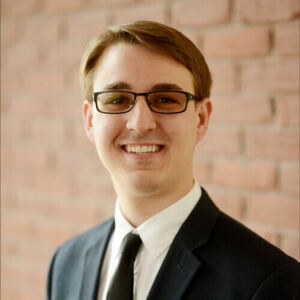Jordan Roach (Burns Group)
Igniting Uranium: The Mechanistic Journey from Nitrate to Oxide
January 18, 2023

Jordan Roach is a fifth-year graduate student advised by Peter C. Burns, the Henry J. Massman Professor of Civil and Environmental Engineering and Earth Sciences and director of ND Energy. He presented "Igniting Uranium: The Mechanistic Journey from Nitrate to Oxide" at the ND Energy PD&GS Seminar in January 2023.
Upon joining the Burns lab, Roach was introduced to a collaboration in the Nuclear Science Laboratory with fellow ND Energy faculty affiliates Ani Aprahamian, the Frank M. Freimann Professor of Physics, and Khachatur Manukyan, associate research professor in the Department of Physics and Astronomy.
Roach’s research focuses on the production of uranium oxides through solution combustion synthesis and the mechanism involved within that process. Uranium oxides are most widely known for their use within the nuclear fuel cycle in the forms of Yellowcake (U3O8) and fuel (UO2). These oxides are typically produced through heating the source material at high temperatures (500-1200 degrees Celsius) over the span of hours.
Solution combustion synthesis offers a more time and energy-efficient means for producing these oxides through reacting metal nitrates and organic fuels.
“These mixtures can be highly reactive, reaching temperatures upwards of 2000 degrees Celsius within seconds with ignition temperatures as low as 150-200 degrees Celsius,” Roach said. “Under these conditions, uranyl nitrate (UO2(NO3)2) can easily be transformed to a variety of its subsequent oxides.”
Using this process, Roach and collaborators have explored bulk reactions to look at the formation of larger quantities of material, as one might use in pressing a pellet to mimic nuclear fuel.
“We have also looked at making very thin films of oxide material through coating the reactive solutions onto thin carbon or aluminum backings to produce targets,” Roach said. “These targets are used within accelerators to help researchers explore nuclear reactions that occur through bombardment of neutrons or charged particles.”
Roach believes this research has great importance not only for its potential application within the nuclear fuel cycle, but also for applications in and out of the nuclear energy realm.
“The work we are pursuing can be used through homogenously incorporating isotopic tracers within the oxide lattice for nuclear forensics,” he said. “Outside of radioactive materials, the work we perform on how intermediate complexes react within the combustion mechanism can be applied to the wider field of combustion research as it continues to grow within the area of materials science.”
As an undergraduate student, Roach double majored in chemistry and philosophy at Saint Michael’s College in Vermont, where he first experienced research, studying heterogeneous catalysis through the synthesis of mesoporous zirconia using ionic liquid templating agents.
“Though I do not work in that area of research now, it did give me an indication of wanting to work more within the realm of materials science,” Roach said.
At the time he was applying for graduate school, Roach was uncertain what area of research he wanted to pursue. Once he toured the laboratories and saw the actinide research the students were doing, he knew Notre Dame would offer a unique experience.
“The facilities and systems we have in place at Notre Dame for training and working with radioactive materials are not common among academic institutions,” Roach said.
Additionally, Roach’s work is aided by the core facilities available on campus, such as ND Energy’s Materials Characterization Facility (MCF) and the Notre Dame Integrated Imaging Facility. In the MCF, Roach primarily utilizes the TGA-DSC.
“Without the aid of the MCF, much of this work would not have been possible,” Roach said, crediting staff members Anna Matzner and Ian Lightcap for their outstanding customer service. “The time they take to listen and work with you on any problem speaks not only to their goal of aiding in good research, but also to assisting with becoming a better researcher.”
After graduation, Roach has accepted a postdoctoral position at Oak Ridge National Laboratory and will work as a uranium chemist within the National Security Sciences Directorate, Nuclear Nonproliferation Division.